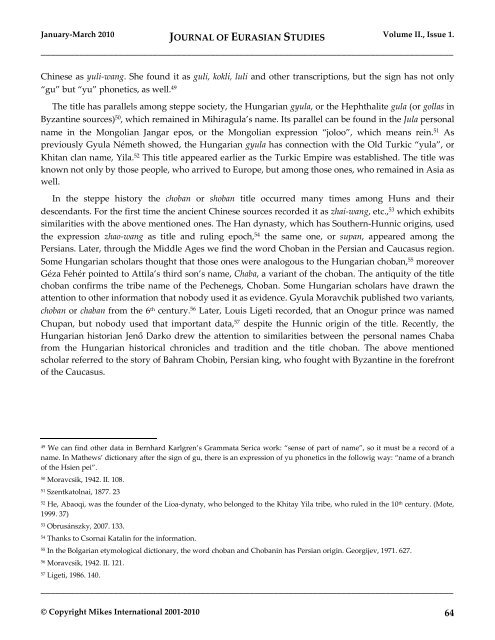EurasianStudies_0110..
EurasianStudies_0110..
EurasianStudies_0110..
You also want an ePaper? Increase the reach of your titles
YUMPU automatically turns print PDFs into web optimized ePapers that Google loves.
January-March 2010 JOURNAL OF EURASIAN STUDIES Volume II., Issue 1.<br />
_____________________________________________________________________________________<br />
Chinese as yuli-wang. She found it as guli, kokli, luli and other transcriptions, but the sign has not only<br />
“gu” but “yu” phonetics, as well. 49<br />
The title has parallels among steppe society, the Hungarian gyula, or the Hephthalite gula (or gollas in<br />
Byzantine sources) 50 , which remained in Mihiragula’s name. Its parallel can be found in the Jula personal<br />
name in the Mongolian Jangar epos, or the Mongolian expression “joloo”, which means rein. 51 As<br />
previously Gyula Németh showed, the Hungarian gyula has connection with the Old Turkic “yula”, or<br />
Khitan clan name, Yila. 52 This title appeared earlier as the Turkic Empire was established. The title was<br />
known not only by those people, who arrived to Europe, but among those ones, who remained in Asia as<br />
well.<br />
In the steppe history the choban or shoban title occurred many times among Huns and their<br />
descendants. For the first time the ancient Chinese sources recorded it as zhai-wang, etc., 53 which exhibits<br />
similarities with the above mentioned ones. The Han dynasty, which has Southern-Hunnic origins, used<br />
the expression zhao-wang as title and ruling epoch, 54 the same one, or supan, appeared among the<br />
Persians. Later, through the Middle Ages we find the word Choban in the Persian and Caucasus region.<br />
Some Hungarian scholars thought that those ones were analogous to the Hungarian choban, 55 moreover<br />
Géza Fehér pointed to Attila’s third son’s name, Chaba, a variant of the choban. The antiquity of the title<br />
choban confirms the tribe name of the Pechenegs, Choban. Some Hungarian scholars have drawn the<br />
attention to other information that nobody used it as evidence. Gyula Moravchik published two variants,<br />
choban or chaban from the 6 th century. 56 Later, Louis Ligeti recorded, that an Onogur prince was named<br />
Chupan, but nobody used that important data, 57 despite the Hunnic origin of the title. Recently, the<br />
Hungarian historian Jenő Darko drew the attention to similarities between the personal names Chaba<br />
from the Hungarian historical chronicles and tradition and the title choban. The above mentioned<br />
scholar referred to the story of Bahram Chobin, Persian king, who fought with Byzantine in the forefront<br />
of the Caucasus.<br />
49 We can find other data in Bernhard Karlgren’s Grammata Serica work: “sense of part of name”, so it must be a record of a<br />
name. In Mathews’ dictionary after the sign of gu, there is an expression of yu phonetics in the followig way: “name of a branch<br />
of the Hsien pei”.<br />
50 Moravcsik, 1942. II. 108.<br />
51 Szentkatolnai, 1877. 23<br />
52 He, Abaoqi, was the founder of the Lioa-dynaty, who belonged to the Khitay Yila tribe, who ruled in the 10 th century. (Mote,<br />
1999. 37)<br />
53 Obrusánszky, 2007. 133.<br />
54 Thanks to Csornai Katalin for the information.<br />
55 In the Bolgarian etymological dictionary, the word choban and Chobanin has Persian origin. Georgijev, 1971. 627.<br />
56 Moravcsik, 1942. II. 121.<br />
57 Ligeti, 1986. 140.<br />
_____________________________________________________________________________________<br />
© Copyright Mikes International 2001-2010 64

















